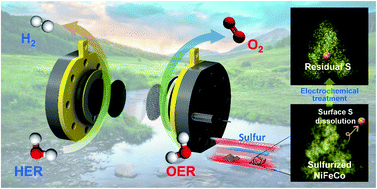Improving the oxygen evolution reaction using electronic structure modulation of sulfur-retaining nickel-based electrocatalysts†
Abstract
The sulfurization of transition metals is a promising method for improving their catalytic activities in the oxygen evolution reaction (OER). However, experimental studies regarding the effects of undissolved, remaining S are rare. Herein, we experimentally elucidate the influence of S in an Ni-based material in enhancing the OER performance. The Fe- and Co-doped sulfurized Ni catalyst prepared using a simple impregnation method with heating under an H2S atmosphere exhibited superior OER activity (271.2 mV at 10 mA cm−2) compared to that of the non-sulfurized analogues while S remained. In situ/operando Raman and X-ray absorption spectroscopy revealed that S at the outermost surface dissolved and accelerated the regeneration of the NiOOH phase during the OER. The remaining S increased the Ni–O bond length of the regenerated NiOOH, thus boosting the OER catalytic activity. These findings provide an understanding of sulfurized catalysts and new perspectives in the development of materials for use in the OER.



 Please wait while we load your content...
Please wait while we load your content...